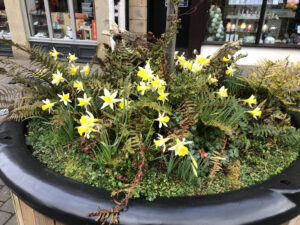Planter Established in November 2018
Location – Opposite Library in Stricklandgate (photo March 2022)
The story behind “Fern Mania”
1850-1900
In Victorian times Kendal was at the centre of a national craze for collecting and growing ferns. Exotic species were introduced from abroad and, together with many varieties of native ferns, these were cultivated in “fern gardens”, often in specially landscaped rockeries or stumperies.

In 2018 the re-emergence of some old pieces of lead bearing obscure Latin inscriptions led to re-newed interest in Kendal’s key role in the Victorian craze (also called “Pteridomania”) for collecting ferns. The labels were probably the work of George Whitwell who looked after Kendal’s Serpentine Wood for 50 years and grew his ferns there. In 1891, George became a founder member of the British Pteridological (Fern) Society. His fern garden, next to his old cottage in Serpentine Wood on the western edge of Kendal, has recently been restored and his gravestone in the Parkside Road cemetery has also been refurbished, funded by the British Fern Society. Cumbria continues to have an active group of fern enthusiasts and national fern collections can be visited close to Kendal at Sizergh Castle and at Holehird Garden near Windermere.
Something to ponder
In Victorian Times, over-zealous collecting of native ferns led to a destruction of some fern habitats in parts of the country. It’s no longer legal to dig up most native plants from the countryside but many species are still decreasing in abundance. Do you think this matters and, if so, what do you think are the main reasons for the continuing declines?
What’s in the Planter and Why?
Centre-piece. The Victorians went to great lengths to create fern gardens, often with artificial constructions of rocks or even large-scale mock-ruins. More modest “stumperies” were created using old tree stumps or roots – and that’s what we’ve done here on a small scale.
Plants. The Victorians were avid hunters of fern varieties and would search high and low to find and name new varieties of ferns. Exotic ferns from across the globe were also brought into the country to satisfy the demand for novelty. Most of the ferns in this planter are native varieties but we’ve also included a few exotics. Can you spot them? We’ve also included a number of flowering plants as companion plants to give flashes of colour. But there is one special plant that deserves a special mention. Its common name is the “Flowering Fern” but this is not really a fern because ferns never never have flowers. The blousy appearance of the Flowering Fern’s pink flowers in early summer may look a bit out of place alongside real ferns. But despite this, it’s a plant that deserves a special place in our planter because it was the chance discovery of one of George Whitwell’s original Victorian lead plant labels stamped with its Latin name (“INCARVILLEA DELAVYII”) that was the motivation for the reconstruction Kendal’s Victorian Fern Garden in 2018. Blouse on flowering fern!
Strictly for the Geeks who Want to Know Exactly What We Planted

References
“The Three-Legged Society” by Ian D. Hodkinson & Allan Steward (2013). University of Lancaster. “George Whitwell: Lakeland fern collector and caretaker of Serpentine Woods, Kendal” by Richard Wrigley (2018). Kendal Civic Society.

